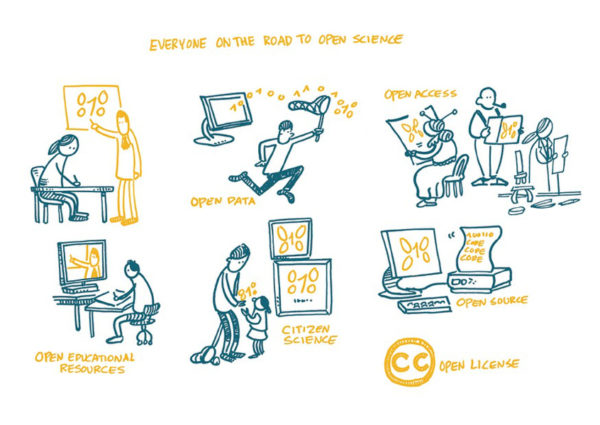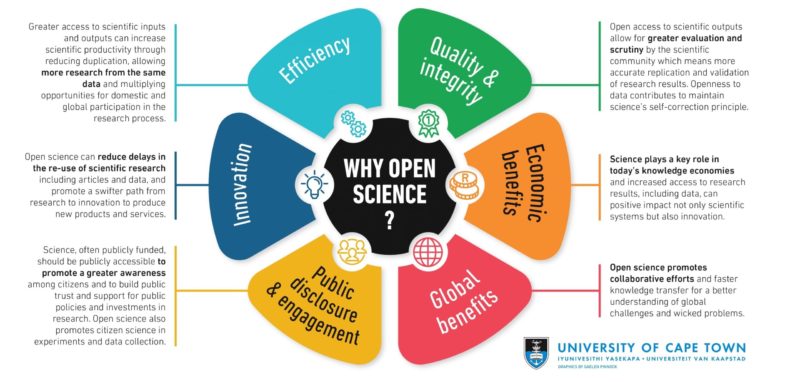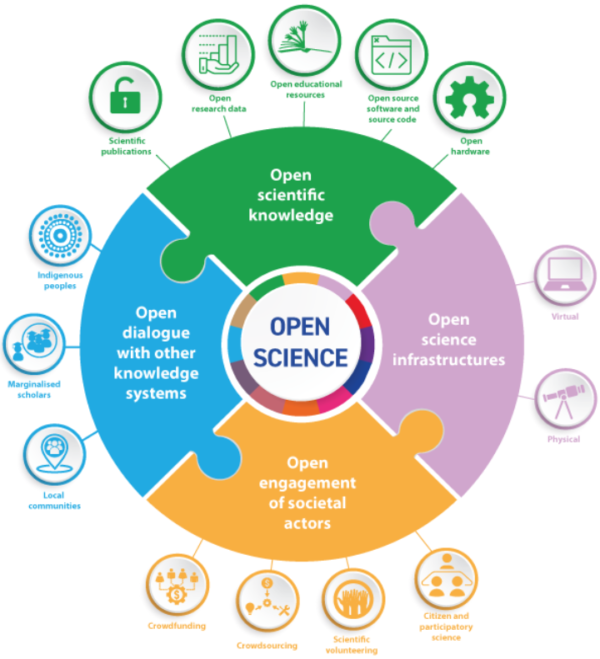This is a library for a generation that understands knowledge, values and ethics are the basis for the development of a more inclusive society
Teresa e Alexandre Soares dos Santos

As illustrated in the image above, open science encompasses diverse processes, professionals, ways of communicating science and can be defined as:
“A new approach to the scientific process based on cooperative work and new ways of diffusing knowledge by using digital technologies and new collaborative tools”
“An inclusive construct that combines various movements and practices aiming to make multilingual scientific knowledge openly available, accessible and reusable for everyone, to increase scientific collaborations and sharing of information for the benefits of science and society, and to open the processes of scientific knowledge creation, evaluation and communication to societal actors beyond the traditional scientific community”
“The practice of science in such a way that others can collaborate and contribute, where research data, lab notes and other research processes are freely available, under terms that enable reuse, redistribution and reproduction of the research and its underlying data and methods”
Therefore, is necessary to emphasize that in this context the term “science” is used to all scholarly disciplines, including social sciences as business and economics (Bezjak et al. 2018) and the four fundamental goals of are:
Open science emerged from the need to communicate science in a more sustainable, collaborative, transparent and agile way. Therefore, it was (and still is) essential to discuss the traditional business models of scientific publications, as well as the current research culture itself. Click here to learn more about the historical context of Open Science.
That said, it is necessary to point out that in order to make scientific contribution accessible to and reusable by all – not only the results but all the processes – the Open Science Model combine principles and practices that “improve the quality and reliability of research” and include changes to the traditional way of doing science (Bezjak et al. 2018). The figure bellow illustrates some of the benefits of Open Science on scholarly research:

Understanding that Open Science accelerates the implementation of Sustainable Development Goals (SDGs), the United Nations Educational, Scientific and Cultural Organization (UNESCO) launched on 2021 the UNESCO Recommendation on Open Science that defines Open Science as “various movements and practices aiming to make multilingual scientific knowledge openly available, accessible and reusable for everyone, to increase scientific collaborations and sharing of information for the benefits of science and society, and to open the processes of scientific knowledge creation, evaluation and communication to societal actors beyond the traditional scientific community” (UNESCO 2021, p. 7).
UNESCO also identifies that Open Science:
“The core values of open science stem from the rights-based, ethical, epistemological, economic, legal, political, social, multi-stakeholder and technological implications of opening science to society and broadening the principles of openness to the whole cycle of scientific research […] The guiding principles for open science provide a framework for enabling conditions and practices within which the above values are upheld, and the ideals of open science are made a reality” (UNESCO 2021, p.17-18).
As mentioned before, the United Nations Educational, Scientific and Cultural Organization (UNESCO) launched, on its 41st session, the Recommendation on Open Science that acknowledges, among other things, that global crises (like COVID-19) proves worldwide the “urgency of and need for fostering equitable access to scientific information, facilitating the sharing of scientific knowledge, data and information, enhancing scientific collaboration and science- and knowledge-based decision making”.

Understanding open science as a public good, UNESCO advocates that:
“Access to scientific knowledge should be as open as possible. Access restrictions need to be proportionate and justified. They are only justifiable on the basis of the protection of human rights, national security, confidentiality, the right to privacy and respect for human subjects of study, legal process and public order, the protection of intellectual property rights, personal information, sacred and secret indigenous knowledge, and rare, threatened or endangered species”.
Open Science is therefore a cross-cutting theme, as illustrated in the figure below, which encompasses scientific, technological, and social contexts, always aiming at faster, cooperative, and sustainable development. However, for our context, it is necessary to deepen the concepts that specifically involve open scientific knowledge, such as open publications and open data.